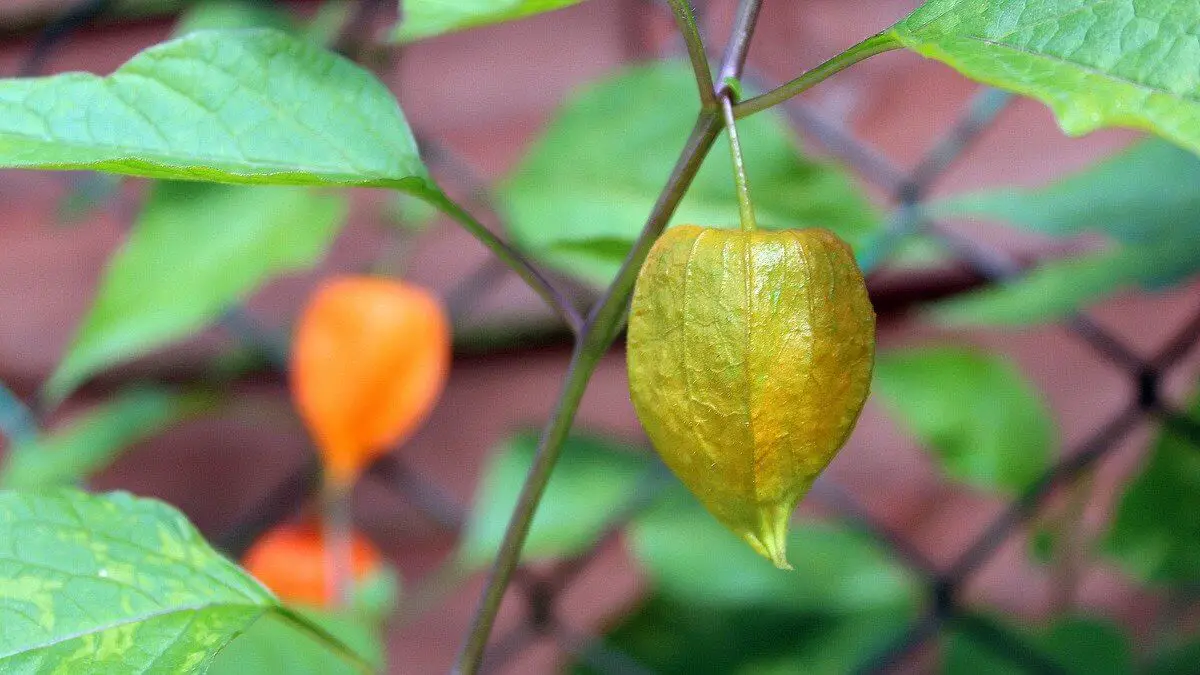Growing Tomatillos in Gardens
Growing tomatillos is a joy and has various benefits. In Spanish, “Tomatillo” means “little tomato”. However, they both are not the same. Tomatillos have various names around the world including Mexican husk tomato, Mexican groundcherry, and large-flowered tomatillo.
This article focuses on growing tomatillos, their varieties, propagation, pollination, harvesting, storing, and uses.
The nightshade (Solanaceae) family consists of many popular members including tomatillos, tomatoes, peppers, and eggplants. Interestingly, the members of this family produce almost similar types of flowers. Hence, they are grouped together for identifying easily.
Tomatillos are indigenous to Mexico and Central America. Since the pre-Columbian era, Mexican growers have been growing these plants. Being staple food, Mexican consumers eat them raw or cook them in a variety of dishes like salsa verde.
Table of Contents
History and Distribution of Tomatillos
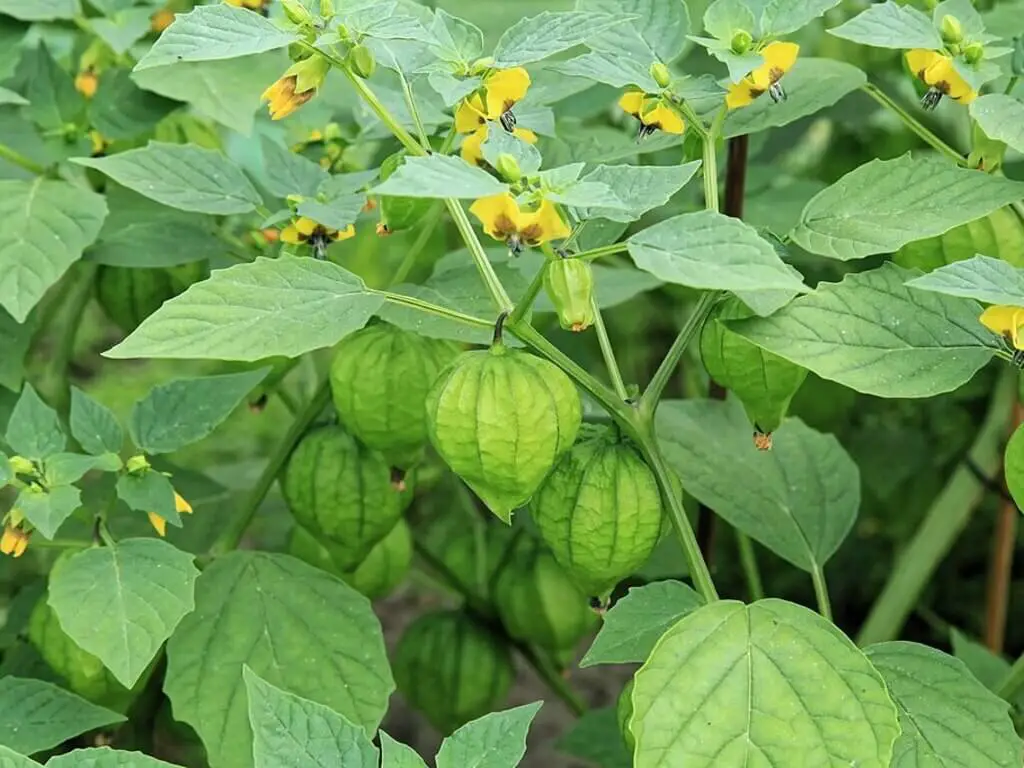
Photo by Frank Vincentz (Creative Commons) (CC BY-SA 3.0)
In 2017, scientists discovered fossil tomatillo in Argentina (Patagonian region) dating back to BP 52 million years. In Mexico, these plants were domesticated even before the European arrival. They played a greater role in Aztec and Mayan cultures.
Various North American native tribes used these fruits to cure stomachache and headache. The University of Kansas confirmed this fact through their “Native Medicinal Research Program”
Throughout the American continent, you can find wild tomatillo plants and their cousins growing profoundly. However, their growth is very less or rare in the far northern American regions due to the environment.
Mexico in particular has the highest diversity of these plants. The Guatemala highlands, Mexican states of Morelos and Hidalgo Etc., are the major host lands of these plants.
Since 1863, the US gardeners have been growing tomatillos. The fruits are sold under various names like jamberry, Mayan husk tomato, jumbo husk tomato Etc., Despite their edibility, people in some parts of the US consider these plants as weeds and invasive ones.
In other regions including Florida, Puerto Rico, Bahamas, Jamaica, etc., you can find an extended distribution of these plants. American Exporters began exporting these plants to other parts of the world including Australia, India, Kenya, and South Africa by the mid-20th century.
Nowadays, people around the world consume tomatillos for their unusual tarty – citrusy flavor. Like Mexicans, some people enjoy them raw while others cook them in various dishes.
Description of Tomatillos
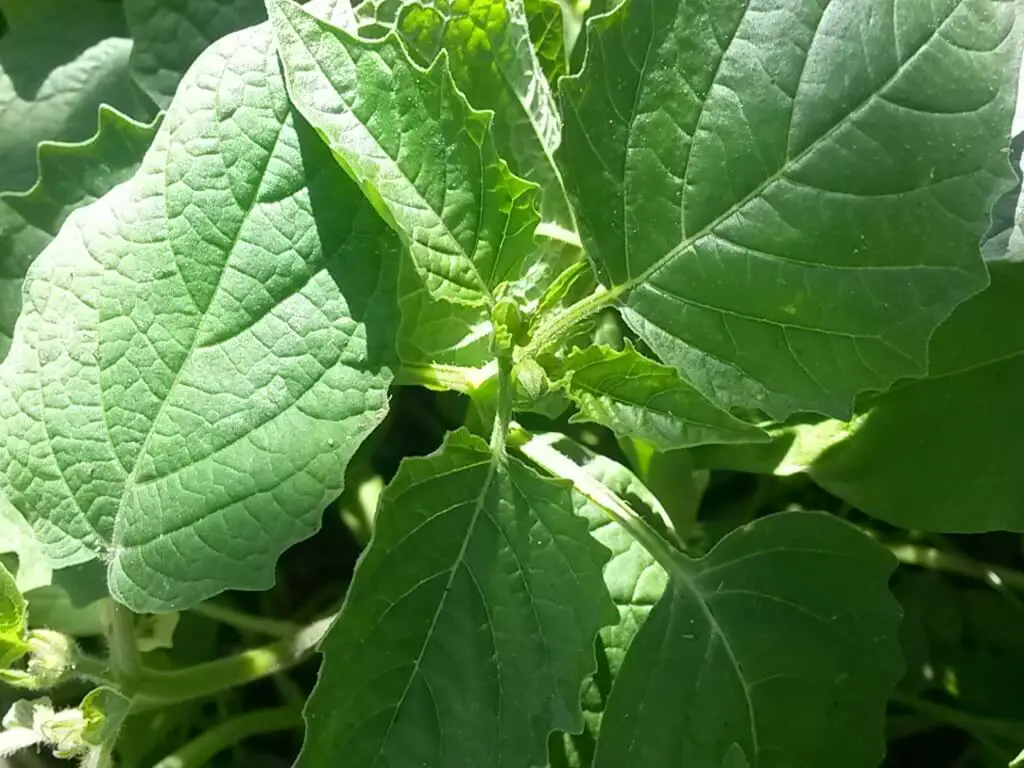
Photo by Horticulturalist RJ (Creative Commons) (CC BY-SA 4.0)
While growing tomatillos, you can easily notice their varying characteristics. Usually, they grow 15 – 60 cm in height. But they can grow to a meter or so in some places. Having few hairs, the stems can grow compact, upright, or prostrate to the ground with a spreading, less dense canopy.
The broad serrated leaves are green in color. They have irregularly separated acute dents on the sides. Usually, they are smooth. But they can be pubescent (with hairs) also in some places.
Usually, the flowers have yellow shades. But they can have purple, white, or light green shades also. Similarly, sometimes they may have purple spots towards the corollas’ center, sometimes not. The anther colors vary from dark purple to pale blue.
Being self-incompatible, isolated plants set fruit rarely. Hence, successful pollination requires the involvement of multiple plants.
An inedible thin husk formed from calyx surrounds tomatillo fruit. As tomatillos grow, they fill the husk and sometimes split open it. With age, the green husks turn brown and weaken. The quality criteria of the fruit include the greenness and freshness of the husk. Upon ripening, the fruits can have various colors including purple, green, or yellow.
Varieties of Tomatillos
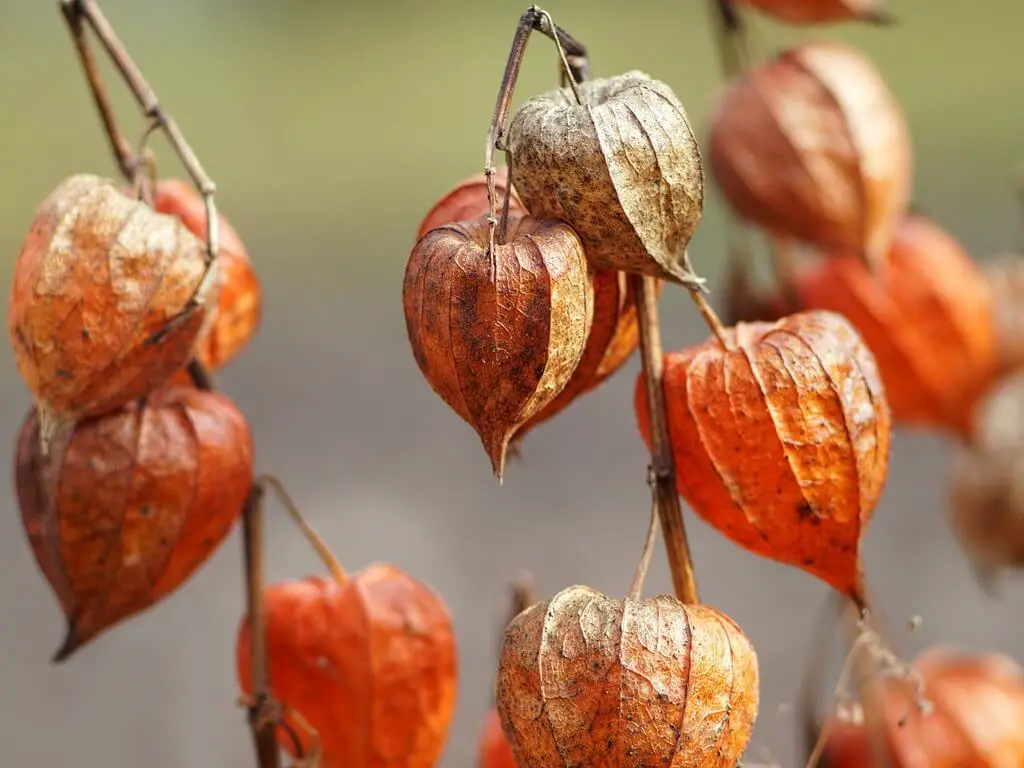
In addition to cultivational processes, the environment in which you are growing tomatillos also has an impact on the fruit. In commercial markets, you can find different varieties of these fruits. They differ in traits, tastes, and ripening colors.
We have mentioned some common varieties of these plants below that are easily available.
Purple – This heirloom variety produces larger, sweeter fruits.
Toma Verde – This traditional variety produces green fruits.
Cisineros – This cultivar produces large green fruits.
Pineapple – This variety produces smaller, sweeter fruits.
Verde Puebla – This variety produces large, golden/yellow-green fruits
Di Milpa – This variety produces small wild fruits.
Amarylla – Upon ripening, the green fruits turn yellow and become sweeter. This variety is suitable to grow in cool northern zones.
Growing Tomatillos – Propagation

Photo by Frank Vincentz (Creative Commons) (CC BY-SA 3.0)
Light
For growing tomatillos, you need a space that receives full sunlight. Like tomatoes, these fruits thrive well and grow healthy under full sun.
Soil
Before planting, amend the soil with organic matter. These plants prefer to grow in slightly moist, well-draining, neutral soil with a pH around 6.5 – 7.0. If needed, aerate the soil well for facilitating drainage.
Temperature and Humidity
In general, these plants like hot summer climates. The locations that have sparse rainfall and temperatures about 80 – 90°F in days and 60 – 70°F at nights are ideal for growing tomatillos.
Although humidity is not a concerning factor, these plants do well in low humid environments. Cooler winters can kill these plants in no time!
Seeds
Purchasing the seeds online is easy. Still, if you prefer, you can collect seeds on your own from the plants. Inside the fruits, the pulp surrounds the seeds. Just squeeze the pulp out and soak it in water for a few hours. This makes seed separation easy. Then, separate the seeds out and dry them on paper towels. After that, store them in a cool, dark, and dry location.
Start seed propagation indoors, 6 – 8 weeks prior to the expected last frost date.
1.) Fill a large pot with a good quality seed starting mixture.
2.) Gently sprinkle the seeds on the pot surface
3.) Press the seeds gently downwards using your fingers. As they need light for germination, you can either barely cover them with soil or leave them without covering.
4.) Using sprayers, gently mist the soil.
In about 4 -7 days, the seeds will germinate, following which, a couple of true leaves sets appear.
After the risks of frost are over, gradually harden the tomatillos seedlings for about a week or so. Then, transplant them carefully outdoors. Make sure to space them at least 3- 4 feet apart. This makes room for the sprawling branches of the plants.
Cuttings
Being easy and most successful, most growers use this method to propagate these plants.
1.) Select a healthy plant. Using good quality garden shears, sever about 6-inch stems at 45 ° angles. This angled cut maximizes the rooting area
2.) From the bottom (1/2) portion of the cuttings, remove the leaves and other debris.
3.) Insert the bottom in a powdered rooting hormone. Then plant them deeply in planting pots filled with starting mixture.
4.) Place the arrangement in a location that receives partial sunlight or dappled sunlight
5.) Water at the base of the cutting as required. But do not overwater or drench the soil.
After the fresh foliage and roots develop, you can transplant the seedlings outdoors. In addition to the bottom tip, the cuttings develop roots on the sides also to feed the plant. Hence, transplant them with extra care avoiding damage to the roots.
Alternatively, you can purchase healthy seedlings from the garden centers and plant them deeply in the gardens directly.
Growing Tomatillos – Pollination
Being non-self-pollinating plants, tomatillos must be grown in groups for effective fruiting. The bright yellow flowers attract pollinators. To attract pollinators further, you can grow companion plants like marigold or nasturtium. Thus, you can facilitate pollination in these plants.
Growing Tomatillos – Caring
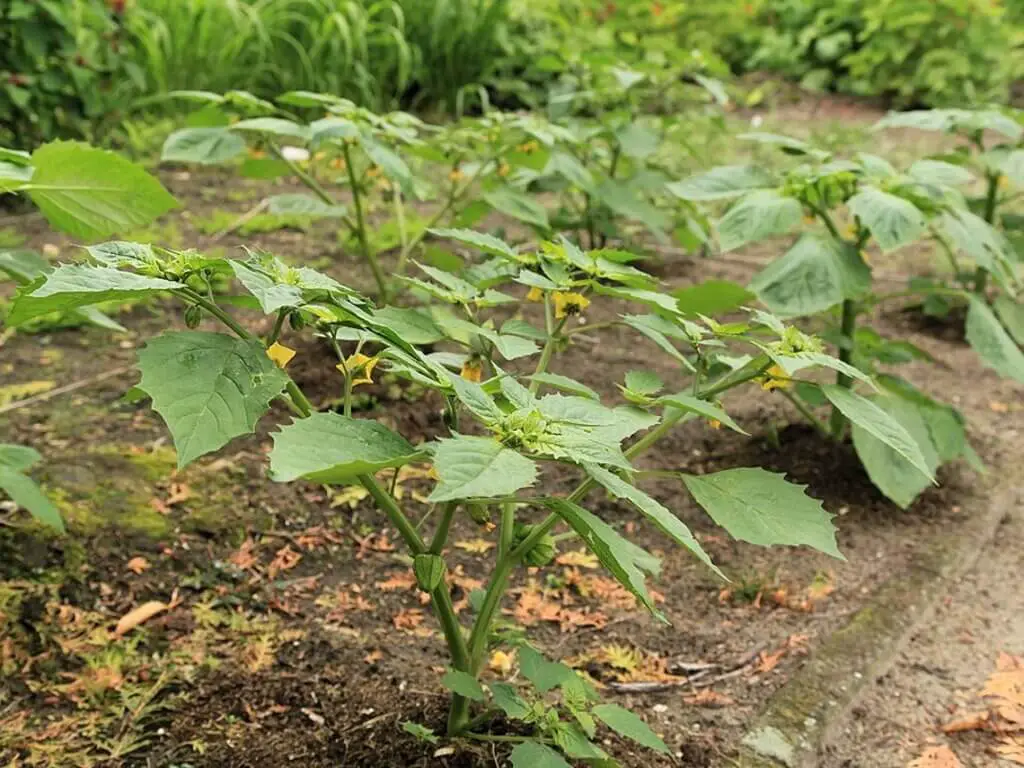
Photo by Frank Vincentz (Creative Commons) (CC BY-SA 3.0)
Water
Although these are drought-tolerant plants, watering about an inch every week helps them to thrive better. If you grow them in containers, keep a watch on soil moisture. Container soils dry quicker than ground soils. Hence, you may need to increase the frequency of watering.
Fertilizer
While growing tomatillos, you may never need fertilizing unless the soil quality is poor. Just work the soil with a bit of compost before planting. This helps the plants to grow healthier.
Mulch
Add 2–3-inch layers of organic mulch around the plants. It conserves moisture in the soil and also suppresses the weeds.
Supporting Sprawls
These plants are known for their semi-determinate characteristics. You may need to support the sprawling branches by installing cages, stakes, trellis Etc.,
Growing Tomatillos – Harvesting
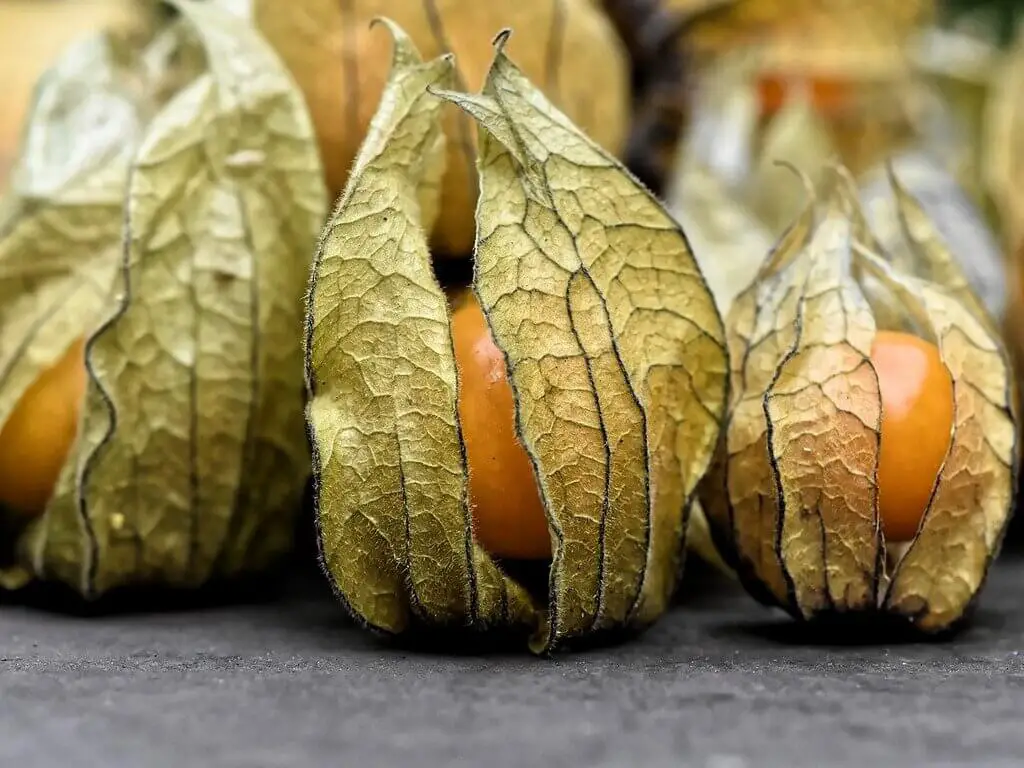
After propagation, you can expect matured fruits in about 60 – 100 days. Ideally, when the fruits fill the husks and the latter just begins to split, you can harvest. Sometimes, the husks turn leathery and brown but won’t split.
When the fruit is under ripen, it remains small and hard. The husks remain quite loose. The seeds would be premature and the fruit tastes sour and has a slight flavor. Until the fruit ripens, keep patience! Don’t hurry to harvest. However, if you want to prepare dishes like salsa verde, you can pick the fruit at this stage.
Contrarily, if you wait too long, the fruit would turn pale yellow. After that, it becomes seedy and loses its distinctive tangy taste. However, you can use over-ripened or rotten fruits in the compost heap.
So, it is recommended to keep a watch during the fruiting season and harvest at the right time. While doing so, use good quality clean garden shears to cut the fruits off. Pulling fruits with bare hands may damage or weaken stems.
Underripe
Husk – Loose husks
Fruits – small and hard in nature
Overripe
Husk – Turns fully dry
Fruits – Turns pale yellow, develop large and hard seeds, loses flavor
The Right Time to Harvest
Husk – begins to dry/split, (sometimes, husks won’t split)
Fruits – Fill the husk, slightly soften, small seeds, best flavor.
Storing Tomatillos
At room temperatures, you can store these fruits for about a week or so. However, you can increase their shelf life by about 3 weeks by refrigerating them. While doing so, use paper bags rather than plastic bags.
Before consumption, peel the husks and wash the fruits in tap water. This removes the sticky residues on them
Pests and Diseases
While growing tomatillos, you have to be watchful for some common pests and diseases.
Pests
Aphids
Using sucking mouthparts, these soft-bodied insects can remove excessive sap from the foliage. As a result, the infected foliage turns yellow and wilts off.
If they are less in number, just blast them with hose water. If the problem persists, use horticultural oil, insecticidal soaps, or Neem oil to treat them effectively.
Cut worms, Tomato Horn worms, Tobacco Bud worms
These pests mostly chew the foliage and stems of young plants. They also chew the fruits from within, which makes them unusable.
Organic measures include sprinkling eggshells or coffee grounds around the plant. Chemicals like Diatomaceous Earth kill the worms effectively.
Whiteflies
In addition to feeding on the underside of the foliage, whiteflies can spread diseases among plants.
Organic measures including Blasting them with hose water, using yellow sticky traps, or growing strong-smelling plants like onion, mints, cilantro, parsley Etc., nearby
If the infection continues treat it with neem oil sprays or insecticidal sprays.
Diseases
Black spot
Normally, this disease causes black spots on leaves. But it spreads to other parts if left untreated. For the treatments to be effective, good air circulation and exposure to sunlight are essential.
You can treat this disease with fungicides like Mancozeb, Daconil, or Funginex.
Tobacco Mosaic Virus
Tobacco mosaic virus causes dwarfing or wilting in affected plants. As a result, the quantity and quality of yield are decreased. This disease transmits to other plants easily through direct contact.
As there is no known cure, it is recommended to remove the infected plant as a whole and dispose it of completely.
Growing Tomatillos – Uses
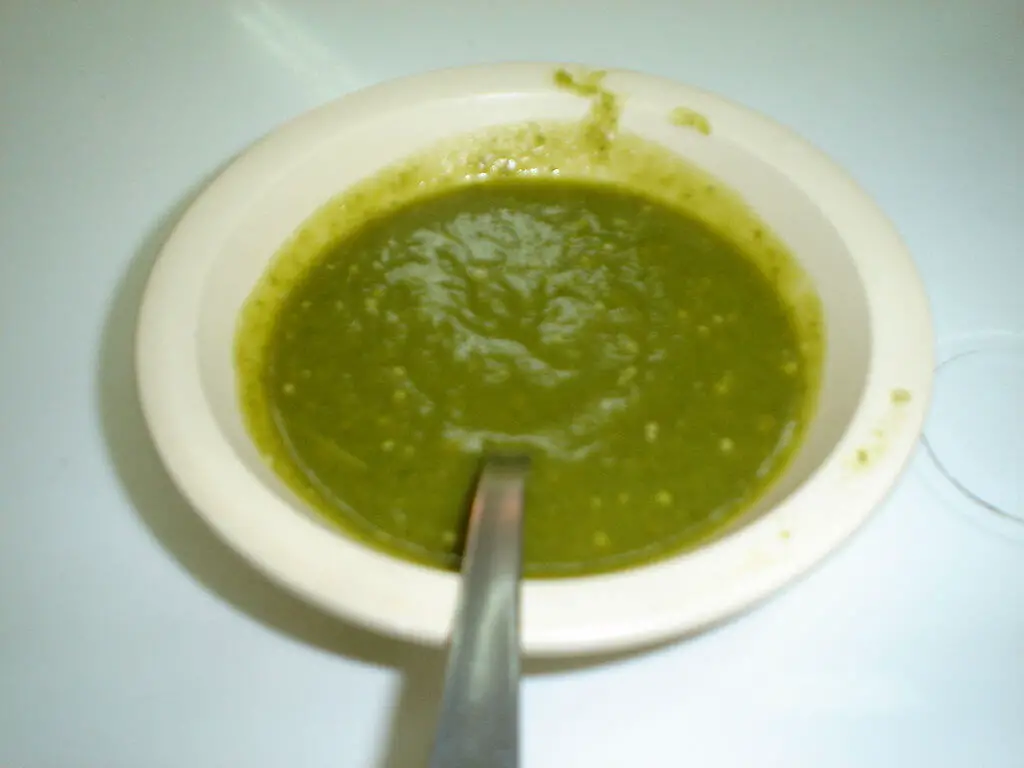
Photo by JEDIKNIGHT1970 (Creative Commons) (CC BY-SA 2.5)
Growing tomatillos is easy and has many culinary uses. You can eat them entirely raw or use cook them in different dishes. Most widely, these fruits are used in soups, salads, stews, stirfries, curries, and bakes. You can also cook them with marmalade, desserts, and meats.
In most American green sauces and Mexican cooked foods, these fruits are used as the key ingredients. Particularly in culinary, most chefs use these fruits for their unusual tarty, tangy flavor and green color.
Typically, the red and purple ripening cultivars have a light sweet flavor. So, some fruit industries use them in preservatives and jams.
Both Cape gooseberries and tomatillos are biologically related plants. They share many similar characteristics. For example, both these plants contain high pectin fiber that is used to thicken jams and jellies.
Similar to cranberries, you can dry tomatillos to further enhance the sweetness in their flavor that has a hint of tomatoes. Infusion cuisines, the flavor of these fruits is used to blend Latin American dish flavors particularly with Europe and North America ones.
Similar Posts
Growing Stinging Nettle in the Gardens
Growing Cumin in Garden

